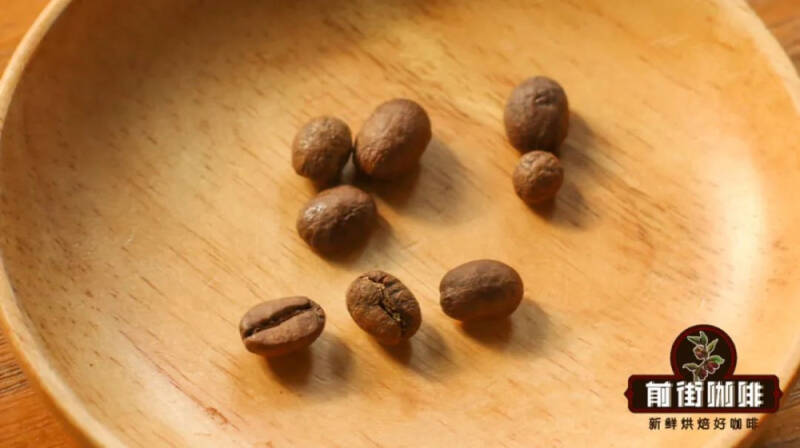Why are coffee beans male and female? What's the difference between arabica round beans and flat beans?
Presumably, when everyone is learning coffee knowledge online, they have more or less brushed the saying that "coffee beans can be divided into male and female". We all know that the core of a regular coffee fruit will contain two raw coffee beans. Is there any difference between the two coffee fruits?

Where do coffee beans come from "male and female"? Let's take a look at the difference between the two beans in the picture below.

The oval beans on the right are called "male beans" by this group of people who say that coffee beans are male and female, while the flat beans on the left are called "mother beans". But in fact, there is no distinction between male and female! The popular "male and female beans" on the Internet is actually found in a pile of coffee beans, two kinds of beans that look different, not two different kinds of beans produced in the same fruit. The original origin of this saying comes from businessmen in Southeast Asia, who made up this lie in order to sell the "public beans" at a higher price, so that they can come up with the saying that "public beans are very rare, accounting for only 5% of the total beans." in order to raise the price of coffee "public beans". Although there is no distinction between male and female coffee beans, and these two different beans do not come from the same fruit, they come from the same tree, and the 5% rarity is also true!
Normally, a coffee fruit produces two raw beans, which are flat beans that snuggle up to each other, but sometimes coffee trees produce fruit with only one raw bean. The main reason is that due to the influence of the environment or its own genes, one ovule in the fruit cannot be pollinated, so the other fruit has plenty of room for growth and can grow more round than the beans that the two embryos grow together. And this raw bean is an oval-shaped bean with no flat surface. In order to distinguish them, independent oval beans are called "Peaberry", and beans with flat surfaces are called flat beans.
Generally speaking, round beans are smaller than flat beans. Under the same variety, if the size of flat bean is 16-18 mesh, then the particle size of round bean will be about 14-15 mesh. Coffee beans are evaluated before they are sold, and the higher the grade, the higher the price. The method of grade evaluation will change according to the different producing areas. So the question is: why mention the grade of coffee beans here? The reason is that there are many countries that rank according to the number of items (size). The bigger the particles of coffee beans are, the more expensive they are, but round beans do not have to be said in this way!
What do you mean? In Kenya, for example, beans reaching 16 to 17 mesh are their AA grade, and the selling price is higher, followed by AB grade, with coffee beans at 15 to 16, price slightly lower than AA; and C, coffee beans at 14 to 15, and the selling price is lower than AB. The grain of round bean is about 1415 mesh, if according to the regulation, its price should be in the price of C grade, but it is round bean! In other words, although round beans are far from reaching the number of items required by high grades, because of their unique and rare characteristics, their selling prices can reach the same as those of AA grade beans! It is precisely because people have made special treatment to round beans, which makes consumers think that the flavor of round beans is bound to be much better than those "ordinary" (flat beans)!
But in fact, there is not much difference between beans of the same origin, variety and planting method (flat beans and round beans), just because it is relatively rare. Therefore, most producing areas will ignore round beans and will not specifically pick them out.
-END-
Front Street Cafe
No. 10 Baoqian street, Yandun road, Dongshankou, Yuexiu district, Guangzhou, Guangdong province
Important Notice :
前街咖啡 FrontStreet Coffee has moved to new addredd:
FrontStreet Coffee Address: 315,Donghua East Road,GuangZhou
Tel:020 38364473
- Prev

Why can't coffee made from a mocha pot be called mocha? How do you make mocha coffee?
"Mocha" is a "permanent resident" in Qianjie articles. It is often seen in coffee history, coffee utensils, or coffee making, and there are three things most often mentioned: the "mocha pot" as a coffee utensil, the "mocha coffee beans" as beans, and, today's popular Italian style.
- Next

Can the latte and hand coffee be reheated after it is cold? Is it good?
It's too cold! The weather in Guangzhou dropped to 15 °C. do you know what it feels like? In addition to the cold, the cooling weather has also brought us a lot of problems, such as insufficient extraction, difficult to perceive the temperature of milking, getting cold before drinking, and so on. For example, Qianjie stores have received more guests and friends recently.
Related
- The milk tea cup becomes smaller?! Overlord Tea Girl launches a new "Return to Yunnan" series
- Accused of selling counterfeit and high-priced coffee beans! Well-known boutique coffee brand "Oukelao" bowed and apologized!
- How to make espresso dumplings? Can I eat coffee and glutinous rice balls together?
- Save the unformed and stagnant powder cakes in one second! What is the problem with stagnant water in the powder bowl of the espresso machine?
- What does hand-brewed coffee stop mean? Why is it not recommended to make coffee by hand?
- Is it normal to smell like coffee? Why does coffee smell like alcohol? What's wrong with the strong smell of cold extract ice dripping ice brewed coffee?
- How to solve the problem that hand-brewed coffee extraction takes too long? Why is the water flowing so slowly when making coffee?
- The main points of making Australian white coffee, the proportion details, how does Australian white properly foam and blend the flowers?
- Can ice water make cold extract coffee? What is the difference between room temperature water and ice water for making cold coffee?
- What milk is best for making latte and white Dirty coffee? What is the difference between different brands of fresh milk and pure milk for making coffee?

